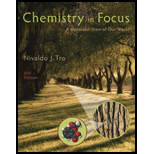
Chemistry In Focus
6th Edition
ISBN: 9781305084476
Author: Tro, Nivaldo J., Neu, Don.
Publisher: Cengage Learning
expand_more
expand_more
format_list_bulleted
Concept explainers
Question
Chapter 12, Problem 3SC
Interpretation Introduction
Interpretation:
Whe Ther the mixture will contain equal masses in the morning is to be determined.
Concept Introduction:
The boiling point of a molecule depends on the intermolecular forces and thermal energy.
Intermolecular forces keep the molecules toge ther. Greater the intermolecular force, higher will be its boiling point.
Intermolecular forces are of two types: dispersion forces and dipole forces.
Dispersion forces are possessed by all the atoms or molecules; it depends upon the molar mass.
Dipole forces exist between polar molecules; it depends upon the polarity of molecules.
Expert Solution & Answer
Want to see the full answer?
Check out a sample textbook solution
Students have asked these similar questions
1. Name the substance, name the group(s) of substances to which this substance belongs. 2. Does this substance contain a functional group or a heteroatom?
How many functional groups are present in the following molecules?
Organic compounds may have characteristic odors as well as other characteristic physical properties. For example, the distinct odor of the seashore at low tide results in part from the presence of dimethyl sulfide (CH3SCH3), a molecule with a similar structure to dimethyl ether (CH3OCH3). Ethanethiol (CH3CH2SH), also called mercaptan, is an isomer of dimethyl sulfide with a much less pleasant odor.The table lists four related compounds and their enthalpies of vaporization (ΔH°vap) in kJ/mol.
Compound
ΔH°vap (kJ/mol)
CH3OCH3
23
CH3SCH3
28
CH3CH2SH
27.5
CH3CH2OH
42
Rank the following compounds in order of increasing strength of their intermolecular forces, given the ΔH°vap listed for each. Place the compound with the strongest intermolecular forces (IMFs) at the top of the list. (Strongest to weaknest).
Why is ΔHºvap for CH3SCH3 greater than ΔHºvap for CH3OCH3?
A. CH3OCH3 is more polar.
B. CH3SCH3 has stronger dipole–dipole attractions.
C. CH3OCH3 can form…
Chapter 12 Solutions
Chemistry In Focus
Ch. 12 - Prob. 12.1YTCh. 12 - Which of the following molecules are polar?...Ch. 12 - Which of the following molecules do you expect to...Ch. 12 - Prob. 12.4YTCh. 12 - Prob. 12.5YTCh. 12 - Prob. 12.6YTCh. 12 - Prob. 12.7YTCh. 12 - Prob. 12.8YTCh. 12 - Prob. 12.9YTCh. 12 - Substance A is composed of molecules that have...
Ch. 12 - A representation of liquid water is shown below....Ch. 12 - Prob. 3SCCh. 12 - Prob. 4SCCh. 12 - Prob. 1ECh. 12 - Prob. 2ECh. 12 - Prob. 3ECh. 12 - Prob. 4ECh. 12 - Prob. 5ECh. 12 - Prob. 6ECh. 12 - Prob. 7ECh. 12 - Prob. 8ECh. 12 - Prob. 9ECh. 12 - Prob. 10ECh. 12 - Why does sweating cool the human body?Ch. 12 - Prob. 12ECh. 12 - Prob. 13ECh. 12 - Prob. 14ECh. 12 - Explain the hydrologic cycle.Ch. 12 - Prob. 16ECh. 12 - Prob. 17ECh. 12 - How does a water softener work?Ch. 12 - Prob. 19ECh. 12 - Prob. 20ECh. 12 - Prob. 21ECh. 12 - What is the SDWA?Ch. 12 - Prob. 23ECh. 12 - Prob. 24ECh. 12 - Prob. 25ECh. 12 - Explain the concerns that groups like the EWG or...Ch. 12 - Prob. 27ECh. 12 - Prob. 28ECh. 12 - Which compound would you expect to have the...Ch. 12 - Which compound would you expect to have the...Ch. 12 - Prob. 31ECh. 12 - Prob. 32ECh. 12 - Classify each molecule as polar or nonpolar:...Ch. 12 - Classify each molecule as polar or nonpolar:...Ch. 12 - Prob. 35ECh. 12 - Prob. 36ECh. 12 - Prob. 37ECh. 12 - Prob. 38ECh. 12 - How many grams of sucrose (C12H22O11) are present...Ch. 12 - How many grams of glucose (C6H12O6) are present in...Ch. 12 - Prob. 41ECh. 12 - How many grams of NaF are present in 4.5 L of a...Ch. 12 - A 250-g sample of hard water contains...Ch. 12 - Prob. 44ECh. 12 - Prob. 45ECh. 12 - Prob. 46ECh. 12 - Prob. 47ECh. 12 - Prob. 48ECh. 12 - Prob. 49ECh. 12 - Prob. 50ECh. 12 - Prob. 51ECh. 12 - Prob. 52ECh. 12 - Prob. 53ECh. 12 - Prob. 54ECh. 12 - Prob. 55ECh. 12 - Prob. 56ECh. 12 - Prob. 57ECh. 12 - Prob. 58E
Knowledge Booster
Learn more about
Need a deep-dive on the concept behind this application? Look no further. Learn more about this topic, chemistry and related others by exploring similar questions and additional content below.Similar questions
arrow_back_ios
arrow_forward_ios
Recommended textbooks for you

 World of Chemistry, 3rd editionChemistryISBN:9781133109655Author:Steven S. Zumdahl, Susan L. Zumdahl, Donald J. DeCostePublisher:Brooks / Cole / Cengage LearningChemistry: Matter and ChangeChemistryISBN:9780078746376Author:Dinah Zike, Laurel Dingrando, Nicholas Hainen, Cheryl WistromPublisher:Glencoe/McGraw-Hill School Pub Co
World of Chemistry, 3rd editionChemistryISBN:9781133109655Author:Steven S. Zumdahl, Susan L. Zumdahl, Donald J. DeCostePublisher:Brooks / Cole / Cengage LearningChemistry: Matter and ChangeChemistryISBN:9780078746376Author:Dinah Zike, Laurel Dingrando, Nicholas Hainen, Cheryl WistromPublisher:Glencoe/McGraw-Hill School Pub Co Chemistry: The Molecular ScienceChemistryISBN:9781285199047Author:John W. Moore, Conrad L. StanitskiPublisher:Cengage Learning
Chemistry: The Molecular ScienceChemistryISBN:9781285199047Author:John W. Moore, Conrad L. StanitskiPublisher:Cengage Learning Introductory Chemistry: An Active Learning Approa...ChemistryISBN:9781305079250Author:Mark S. Cracolice, Ed PetersPublisher:Cengage Learning
Introductory Chemistry: An Active Learning Approa...ChemistryISBN:9781305079250Author:Mark S. Cracolice, Ed PetersPublisher:Cengage Learning Introductory Chemistry: A FoundationChemistryISBN:9781337399425Author:Steven S. Zumdahl, Donald J. DeCostePublisher:Cengage Learning
Introductory Chemistry: A FoundationChemistryISBN:9781337399425Author:Steven S. Zumdahl, Donald J. DeCostePublisher:Cengage Learning


World of Chemistry, 3rd edition
Chemistry
ISBN:9781133109655
Author:Steven S. Zumdahl, Susan L. Zumdahl, Donald J. DeCoste
Publisher:Brooks / Cole / Cengage Learning

Chemistry: Matter and Change
Chemistry
ISBN:9780078746376
Author:Dinah Zike, Laurel Dingrando, Nicholas Hainen, Cheryl Wistrom
Publisher:Glencoe/McGraw-Hill School Pub Co

Chemistry: The Molecular Science
Chemistry
ISBN:9781285199047
Author:John W. Moore, Conrad L. Stanitski
Publisher:Cengage Learning

Introductory Chemistry: An Active Learning Approa...
Chemistry
ISBN:9781305079250
Author:Mark S. Cracolice, Ed Peters
Publisher:Cengage Learning

Introductory Chemistry: A Foundation
Chemistry
ISBN:9781337399425
Author:Steven S. Zumdahl, Donald J. DeCoste
Publisher:Cengage Learning